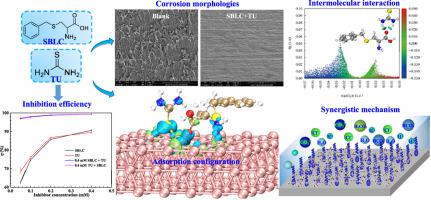Corrosion Science ( IF 7.4 ) Pub Date : 2021-09-01 , DOI: 10.1016/j.corsci.2021.109807 Q.H. Zhang 1 , Y.Y. Li 1 , G.Y. Zhu 1 , Y. Lei 1 , X. Wang 1 , H.F. Liu 1, 2 , G.A. Zhang 1

|
Mixing is an effective strategy to improve the inhibition performance of corrosion inhibitors based on their synergistic effect. In this work, the synergistic inhibition effect of S-benzyl-L-cysteine (SBLC) and thiourea (TU) on the corrosion of carbon steel in the CO2-saturated oilfield produced water is studied by electrochemical tests and surface analysis. It is found that SBLC and TU exhibit a significant synergistic corrosion inhibition effect. Meanwhile, the synergistic mechanism is in-depth elucidated by theoretical calculations. The intermolecular interaction between SBLC and TU molecules leads to the formation of a more compact and stronger adsorbed film on carbon steel surface.
中文翻译:

CO2饱和油田采出水中S-苄基-L-半胱氨酸与硫脲协同抑制碳钢腐蚀机理的深入洞察
基于缓蚀剂的协同作用,混合是提高缓蚀剂缓蚀性能的有效策略。本工作通过电化学测试和表面分析研究了S-苄基-L-半胱氨酸(SBLC)和硫脲(TU)对CO 2饱和油田采出水中碳钢腐蚀的协同抑制作用。发现SBLC和TU表现出显着的协同缓蚀作用。同时,通过理论计算深入阐明了协同机制。SBLC 和 TU 分子之间的分子间相互作用导致在碳钢表面形成更致密和更强的吸附膜。































 京公网安备 11010802027423号
京公网安备 11010802027423号